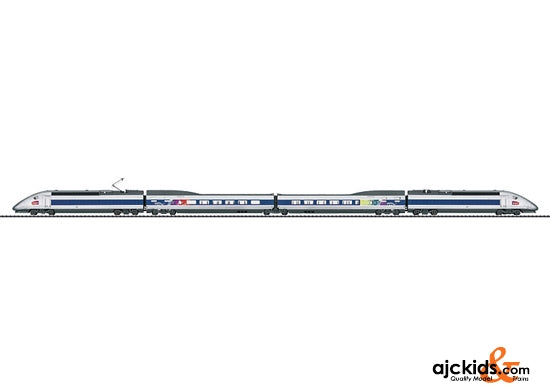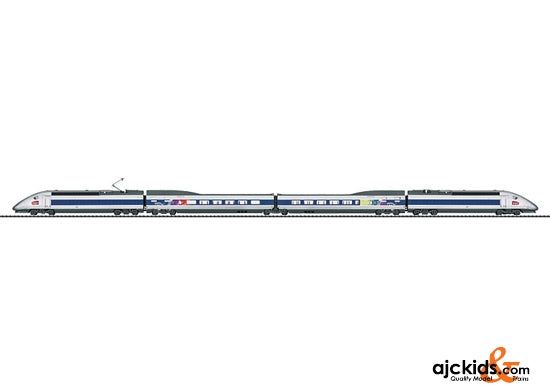Trix 22364 - High Speed Train TGV
Prototype: French State Railways (SNCF) TGV POS (train à grande vitesse) high speed train, in the version for service between Paris and Southern Germany. 2 powered end cars, 1 transition car (R1), 1st/2nd class, 1 transition car (R8), 2nd class. The train looks as it currently does in real life in 2009/2010.
Highlights
- Completely new tooling.
- Scale 1:87 reproduction.
- Factory-installed interior lighting.
- Warm white LEDs for lighting.
- 21-pin digital connector (no decoder installed).
- The latest paint scheme.
- Both end cars powered.
Product
Model: Era VI. The train is a 4-part set. Both powered end cars (TK1 and TK2) have a motor. The train has a 21-pin digital connector. It has controlled, high-efficiency propulsion in both powered end cars, centrally mounted. 4 axles on each end car powered through cardan shafts. Traction tires. The train has factory-installed interior lighting. The triple headlights and dual red marker lights change over with the direction of travel. They and the interior lighting will work in conventional operation. The headlights and interior lighting are maintenance-free, warm white LEDs and the marker lights are maintenance-free red LEDs.
The train has separately applied metal grab irons. It also has inset windshield wipers. The engineer's cabs in the powered end cars have interior details. Each powered end car and a transition car are permanently coupled together in pairs and have special close couplings with a guide mechanism. There is an additional guide mechanism in the Jakobs truck. In analog operation only one end car picks up power. After installation of a decoder, there is a power pickup feature so that the end car at the front of the train picks up power. The interior lighting is powered through a continuous electrical connection through the entire train. Each powered end car has 2 different design single-arm pantographs, one with a wiper for the DB catenary and one with a wiper for the SNCF catenary. The pantographs work mechanically but are not wired to take power. The train is a scale reproduction.
The minimum radius for operation is therefore 360 mm / 14-3/16", when there is sufficient clearance on both sides.
Length of the 4-part set 101 cm / 39-3/4".
Product info
The 22364 basic set can be expanded with the 23438, 23439, and 23444 extension sets to a prototypical 10-car unit. SNCF and TGV are registered trademarks of the SNCF. SNCF is the owner of the TGV®. All rights reserved regarding copying and/or reproduction.
This model can be found in an AC version in the Märklin H0 assortment under item no. 37790.
Publications
- New Items 2010 - Main Catalog 2010/2011 - Main Catalog 2011/2012 - Main Catalog 2012/2013Prototype information
The French railroad SNCF purchased the "Train à Grande Vitesse Paris - Ostfrankreich – Südwestdeutschland" (TGV POS) for high speed service between Paris, Eastern France (Strasbourg), and Southern Germany. The core of the TGV POS was initially the new construction of the high speed route, which is planned to connect Strasbourg better with Paris. A trip of four hours was simply no longer tolerable if the railroad was to compete effectively with people driving cars. The new route with a maximum speed of 350 km/h / 218.75 mph was planned to be 430 kilometers / 269 miles long and also make connections to Nancy, Reims, Luxembourg, and Basle. The TGV Est trains were planned to travel at 350 km/h / 218.75 mph. On May 9, 2000, the DB AG and the SNCF agreed on standardization of cross-border cars and powered units, routes, and signals. Due to the short time plan and several disagreements there was no common high speed train. Instead, a mixed operation of ICE and TGV was planned.
Both trains had to pass a great many test runs in the two countries in order to receive permission for operation. The TGV POS is not really a generation of cars and powered units that has been developed totally from scratch. The TGV POS is more a mix of new powered end cars and intermediate cars from the TGV Réseau. The new powered end cars are mechanically very similar to those of the TGV Thalys PBKA (Paris - Brussels - Cologne – Amsterdam). The electrical equipment for three current systems (25 kilovolts / 50 Hertz as well as 1.5 kilovolts DC in France, 15 kilovolts / 16-2/3 Hertz in Germany and Switzerland) is being done for the first time using asynchronous technology with IGBT-controlled three-phase asynchronous motors. Two pantographs are located on the roof. The one with a contact strip 1,650 mm / 64-15/16" wide is used for 25 kilovolts / 50 Hertz in France and in Switzerland; the second one with a contact strip 1,950 mm / 76-3/4" wide and metallic plated carbon contact strips is used in Germany. In France the 1,950 mm / 76-3/4" pantographs on both powered end cars must be up under the 1.5 kilovolt catenary due to the high level of current. The intermediate cars come from the TGV Réseau. However, they were extensively modernized and brought up to the laterst technical standard at the workshops in Bischheim; they therefore differ strikingly from the other generations of TGV trains. A train set consists of two powered end cars and eight intermediate cars. The intermediate cars are connected to each other by means of Jakobs trucks and thereby form an operational unit. Five intermediate cars (one with a bar) are intended for passengers in 2nd class and three intermediate cars are for 1st class.
The approximately 200 meter / 656 foot TGV POS has seating for 360 passengers. Nineteen units have been purchased with the road numbers 4401 to 4419, whereby road number 4406 was sold recently to the SBB. In France the trains are allowed to run at a maximum speed of 320 km/h / 200 mph; in Germany the maximum speed allowed on the high speed routes is 250 km/h / 156 mph. TGV road number 4402 is a special train. Its powered end cars along with three modified intermediate cars set a new, unbelievable speed record for rail vehicles as World Record Train V150 at noon on April 3, 2007 on the route LGV Est. In 13 minutes this train accelerated to 574.8 km/h / 359.25 mph. The two powered end cars have kept their striking world record lettering, which immediately draws attention to the attempted speed. They can be seen occasionally in the Swabian part of Germany.



